The Chiefs once again flipped a regular-season loss to the Bills into a playoff win, continuing a series that keeps seeing Buffalo’s Super Bowl path blocked despite the AFC East champions holding their own in the matchup. After an injury-battered Bills defense came up short in Round 2 last year, the team set about a retooling effort that featured more notable changes on the other side of the ball. Josh Allen has a new-look receiving corps. For the first time since his ascent to superstardom, the do-it-all QB will not be targeting Stefon Diggs.
Additional Bills moves centered on cap-based adjustments, with a few longtime starters — some longer in the tooth, others who had dealt with injuries — also out of the picture. As a result, curiosity surrounds Sean McDermott‘s team and perhaps the eighth-year HC’s status. But the Bills still have Allen and many key pieces from their early-2020s stay atop their division. While they should still remain a factor in the Super Bowl chase, plenty of eyes will be on this team as it reshapes its blueprint to reach its long-sought-after goal.
Trades:
- Acquired 2025 second-round pick from Texans for WR Stefon Diggs, No. 189, 2025 fifth-rounder
- Obtained No. 144 from Bears for OL Ryan Bates
 As difficult as it appeared Diggs was for the Bills to manage at points, his 2020 arrival played a pivotal role in Allen catapulting toward his current place in the game. The 2018 first-round pick took a seminal step in Diggs’ debut, and the former Vikings draftee became one of the NFL’s most consistent pass catchers in Buffalo.
As difficult as it appeared Diggs was for the Bills to manage at points, his 2020 arrival played a pivotal role in Allen catapulting toward his current place in the game. The 2018 first-round pick took a seminal step in Diggs’ debut, and the former Vikings draftee became one of the NFL’s most consistent pass catchers in Buffalo.
The Allen-Diggs tandem produced three straight 1,200-plus-yard seasons, with Year 1 doubling as Diggs’ lone first-team All-Pro showing. The elite route runner also displayed durability for a Bills team that shuffled through second bananas in the passing game, missing only one contest in four seasons. Though, last year brought some concerning signs.
Diggs, 30, struggled down the stretch, averaging only 41 yards per game and scoring just once over the Bills’ final 10 contests; Joe Brady‘s offense did not coax the nine-year veteran’s best work. Diggs’ 1,183-yard season brought speedbumps and produced a brutal final act — dropping a well-placed Allen deep ball late in another narrow January loss to the Chiefs.
Diggs’ sudden production decline came a year after he stormed out of Buffalo’s locker room following a one-sided loss to Cincinnati. During the 2023 offseason program, Diggs left the Bills’ facility unexpectedly — before McDermott called the confusing matter, which may or may not have stemmed from the wideout’s role in the offense, “very concerning.” A year later, Diggs will be asked to help the Texans develop C.J. Stroud.
 A report pointed to the Texans including a 2025 second-rounder as changing Buffalo brass’ mind on retaining the WR. That said, this trade brought a non-QB record for single-player dead money ($31.1MM). That full amount is on the Bills’ 2024 cap sheet. Considering what it cost the Bills to trade their top target, it clearly did not take too much convincing on the Texans’ part. Indeed, an April report indicated Diggs’ antics had worn thin and Bills higher-ups were ready to move on. Ultimately, Diggs (zero TDs with Brady at the controls) expected to be traded for a second time.
A report pointed to the Texans including a 2025 second-rounder as changing Buffalo brass’ mind on retaining the WR. That said, this trade brought a non-QB record for single-player dead money ($31.1MM). That full amount is on the Bills’ 2024 cap sheet. Considering what it cost the Bills to trade their top target, it clearly did not take too much convincing on the Texans’ part. Indeed, an April report indicated Diggs’ antics had worn thin and Bills higher-ups were ready to move on. Ultimately, Diggs (zero TDs with Brady at the controls) expected to be traded for a second time.
The Texans had pursued Keenan Allen; they needed to give the Bills more than the Bears sent the Chargers. Houston curiously removed the final three seasons of Diggs’ Bills-constructed extension — four years, $96MM — in a reported effort to better motivate the veteran playmaker. That odd decision will put Diggs on track for free agency come March, barring an extension before that point. Diggs exiting western New York with four years remaining on his contract injects uncertainty into the Bills’ equation, as Allen’s age-28 season does not seem likely to include a true No. 1 receiver. Allen has obviously displayed tremendous growth since his rocky pre-Diggs years, but his team has an issue to sort out soon.
Playing on a Bears-designed contract for the past two seasons, Bates is now part of that team. The Bills matched the Bears’ RFA offer sheet during Ryan Poles‘ first offseason running the NFC North franchise, but after using Bates as a starter in 15 games in 2022, they demoted him upon adding guards Connor McGovern and O’Cyrus Torrence. Bates worked strictly as a backup last season; the 27-year-old blocker is vying for Chicago’s starting center role while giving the team an option at right guard.
Extensions and restructures:
- Extended LT Dion Dawkins for three years, $60.06MM ($30.21MM guaranteed)
- Reached three-year, $30.75MM ($16.65MM guaranteed) extension with CB Taron Johnson
- Moved to restructure QB Josh Allen‘s contract, creating $16.7MM in cap space
- Agreed to restructure with DE Von Miller, clearing $8.65MM in cap space
- Opted to restructure TE Dawson Knox‘s contract, creating $6.7MM in cap room
- Adjusted C Connor McGovern‘s contract, clearing $3.74MM in cap room
- Restructured CB Rasul Douglas‘ deal, freeing up $2.5MM in cap space
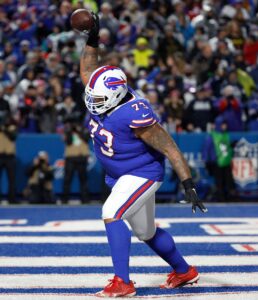 More attention surrounded the players the Bills lost this offseason, but the team paid two core performers. Dawkins is the longest-tenured Bills left tackle since Jim Kelly– and Doug Flutie-era blindsider John Fina. Only Fina (131) and 1970s and ’80s LT bastion Ken Jones (130) have served longer in this role. Carrying 106 career starts, Dawkins will have a chance to top this list during the 2025 season. Cordy Glenn‘s LT successor has made the past three Pro Bowls, anchoring an O-line that has seen changes come to pass everywhere else during his eight-year tenure.
More attention surrounded the players the Bills lost this offseason, but the team paid two core performers. Dawkins is the longest-tenured Bills left tackle since Jim Kelly– and Doug Flutie-era blindsider John Fina. Only Fina (131) and 1970s and ’80s LT bastion Ken Jones (130) have served longer in this role. Carrying 106 career starts, Dawkins will have a chance to top this list during the 2025 season. Cordy Glenn‘s LT successor has made the past three Pro Bowls, anchoring an O-line that has seen changes come to pass everywhere else during his eight-year tenure.
Pass block win rate placed Dawkins fourth overall among tackles last season, and Pro Football Focus has ranked him outside the top 25 among tackles only once (2018). Dawkins, 30, has also avoided injuries. A second-round pick during the draft McDermott and Doug Whaley shepherded (one that also produced Tre’Davious White and Matt Milano), Dawkins has been one of the team’s catalysts during this rise. This third contract should include more prime years for the Temple product, who is now the NFL’s sixth-highest-paid LT. Given Dawkins’ stability, the Bills having him at this rate represents good value.
Coming into the offseason, the slot cornerback market had stagnated. Neither Johnson nor Kenny Moore were able to score deals beyond where 2010s All-Decade slot Chris Harris went ($8.5MM AAV) during the 2014 season. Both current AFC slot staples finally elevated the market to eight-figure-per-year territory. Moore re-signed with the Colts at three years and $30MM; Johnson topped that days later to become the league’s highest-paid inside corner. The Bills CB’s guarantee at signing also narrowly topped Moore’s $16MM figure, which is impressive considering the latter hit free agency.
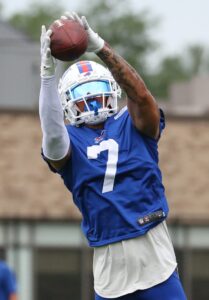 During Johnson’s second contract, the Bills have seen their outside corners struggle to either stay healthy (Tre’Davious White) or justify a first-round investment (Kaiir Elam). Johnson, meanwhile, has anchored Buffalo’s CB corps during the 2020s. PFF gave the 2018 fourth-rounder a career-best grade last season, ranking him 17th among all corners, and his 7.4 yards per target figure was his best mark since his rookie season. Johnson also forced three fumbles in 2023. As the Bills transition from White, they will need Johnson (28) to keep delivering top-shelf work inside.
During Johnson’s second contract, the Bills have seen their outside corners struggle to either stay healthy (Tre’Davious White) or justify a first-round investment (Kaiir Elam). Johnson, meanwhile, has anchored Buffalo’s CB corps during the 2020s. PFF gave the 2018 fourth-rounder a career-best grade last season, ranking him 17th among all corners, and his 7.4 yards per target figure was his best mark since his rookie season. Johnson also forced three fumbles in 2023. As the Bills transition from White, they will need Johnson (28) to keep delivering top-shelf work inside.
Miller’s status loomed as tenuous during a season in which he was clearly hampered by a second ACL tear. The year ended with the future Hall of Famer being arrested on a third-degree felony charge of assaulting a pregnant person. Both Miller and the alleged victim, his girlfriend, denied a crime occurred. An NFL suspension would void Miller’s remaining guarantees — $8.5MM for 2024. After this year, no guaranteed money remains on a deal that has not worked out the way the Bills hoped. Nothing has come out in 2024 regarding any potential punishment for the 35-year-old edge rusher, and the Bills restructuring the deal firmly keeps Miller in their plans.
The former Broncos and Rams superstar said he is 100% healthy; he is now nearly 21 months removed from the knee injury that ended his 2022 season — a promising campaign that featured eight sacks in 11 games — and sidetracked his 2023 slate. Miller played in 12 games, starting none, last season and did not resemble the dominant sack artist the Bills signed for $20MM per. The team will hope the 14th-year vet has another rebound season in him, as it lost Leonard Floyd in free agency. Due to this restructure, the Bills would take on $15.4MM in dead money if they released Miller next year.
 Allen denied he is unhappy with his contract, but the Bills have an incredible bargain atop their payroll. Their $43MM-per-year Allen accord has aged remarkably well, as the perennial MVP candidate — after Jared Goff, Trevor Lawrence, Tua Tagovailoa and Jordan Love joined the $50MM-AAV club — is the NFL’s 13th-highest-paid QB. The Bills could move money around the way the Chiefs did to accommodate Patrick Mahomes‘ deal.
Allen denied he is unhappy with his contract, but the Bills have an incredible bargain atop their payroll. Their $43MM-per-year Allen accord has aged remarkably well, as the perennial MVP candidate — after Jared Goff, Trevor Lawrence, Tua Tagovailoa and Jordan Love joined the $50MM-AAV club — is the NFL’s 13th-highest-paid QB. The Bills could move money around the way the Chiefs did to accommodate Patrick Mahomes‘ deal.
Thus far, Allen is the only QB who has emulated Mahomes by signing an extension longer than five years. The six-year pact Allen signed runs through 2028, and like Mahomes’ deal, Allen’s has extended space for base-to-bonus restructures. The Bills took advantage of that flexibility in March.
The Bills will need to address this matter in the not-too-distant future. With five more seasons on the contract, the team can sit tight for now. As is the case with Mahomes and the Chiefs, however, the QB carries significant leverage due simply to his franchise-elevating skillset. It will be interesting to see if the seventh-year passer uses it soon, especially when factoring in the run-game role the former No. 7 overall pick has taken on — only two QBs (Lamar Jackson and Cam Newton) have logged more carries through six seasons — thus far in his career.
Free agency additions:
- Curtis Samuel, WR. Three years, $24MM ($14.02MM guaranteed)
- Austin Johnson, DT. One year, $3.5MM ($3.05MM guaranteed)
- Mitch Trubisky, QB. Two years, $5.25MM ($2.71MM guaranteed)
- Marquez Valdes-Scantling, WR. One year, $2.25MM ($2.25MM guaranteed)
- Dawuane Smoot, DE. One year, $2.5MM ($1.75MM guaranteed)
- Mike Edwards, S. One year, $2.8MM ($1.6MM guaranteed)
- La’el Collins, OL. One year, $1.75MM ($1.5MM guaranteed)
- Mack Hollins, WR. One year, $2.6MM ($1.1MM guaranteed)
- Nicholas Morrow, LB. One year, $1.5MM ($750K guaranteed)
- Will Clapp, OL. One year, $1.29MM ($288K guaranteed)
- Casey Toohill, DE. One year, $1.16MM ($15K guaranteed)
- DeShawn Williams, DT. One year, $1.16MM ($15K guaranteed)
- Damiere Byrd, WR. One year, $1.21MM
- Kareem Jackson, S. One year, $1.21MM
- Deion Jones, LB. One year, $1.21MM
- Dee Delaney, CB. One year, $1.13MM
- KJ Hamler, WR. One year, $1.1MM
Buffalo began to reassemble its wide receiver pieces in March, though Samuel and Hollins joined the team when Diggs was still expected to be the WR1. This equation soon involved Valdes-Scantling, Byrd, Hamler and Chase Claypool. The twice-traded WR, however, is out of the picture via an injury settlement. Holdover Khalil Shakir and second-round pick Keon Coleman figure to lead the way for the Bills, with a heavy assist from TEs Dalton Kincaid and Dawson Knox, but the team will need auxiliary help at least from free agents.
 Samuel, 28, worked with Brady during the latter’s first season as Carolina’s OC. The former second-round pick eclipsed 600 receiving yards in each of the past two seasons, profiling as more of a slot/gadget weapon than an outside option. ESPN’s Open Score metric rated Samuel as a bottom-20 wideout last season, but the Ohio State alum is known for short-area production. However, the Bills relied on Shakir in this role late last season. It will be interesting to see how the team uses the third-year player and veteran FA addition together.
Samuel, 28, worked with Brady during the latter’s first season as Carolina’s OC. The former second-round pick eclipsed 600 receiving yards in each of the past two seasons, profiling as more of a slot/gadget weapon than an outside option. ESPN’s Open Score metric rated Samuel as a bottom-20 wideout last season, but the Ohio State alum is known for short-area production. However, the Bills relied on Shakir in this role late last season. It will be interesting to see how the team uses the third-year player and veteran FA addition together.
A Chiefs cap casualty, Valdes-Scantling drew interest from multiple teams. He struggled for most of last season before making some crucial contributions — including two long-range grabs against the Bills — in the playoffs. MVS sustained a neck injury and may not be ready for Week 1. This obviously hurts the ex-Packers and Chiefs deep threat’s roster chances, as he was viewed as a bubble player recently.
Despite carrying a lower profile and making fewer career starts (60-27), Hollins consistently played ahead of Valdes-Scantling in camp. Set to turn 31 in September, Hollins has surpassed 250 receiving just once in his seven-year career. It would be odd for the Bills to give Hollins a key role, but he appears a roster lock. The Bills also worked out Corey Davis recently, adding intrigue to a group that does not seem full yet. This is an area to monitor ahead of November’s trade deadline.
 Allen has not missed a game due to injury since his rookie season, but he has run into health issues over the past two seasons. This makes the Bills’ backup plan curious, as Trubisky has generally inspired little confidence since being a defining QB bust. The Bills rostered Trubisky in 2021 and quickly brought him back following the Steelers’ release. Trubisky beat out Mason Rudolph for Pittsburgh’s QB2 gig last season and received the first crack when Kenny Pickett went down. The former No. 2 overall pick lost the job and watched Rudolph excel down the stretch. Trubisky, 30, averaged just 5.9 yards per attempt last season, lost both his starts and finished with a 4-5 TD-INT ratio.
Allen has not missed a game due to injury since his rookie season, but he has run into health issues over the past two seasons. This makes the Bills’ backup plan curious, as Trubisky has generally inspired little confidence since being a defining QB bust. The Bills rostered Trubisky in 2021 and quickly brought him back following the Steelers’ release. Trubisky beat out Mason Rudolph for Pittsburgh’s QB2 gig last season and received the first crack when Kenny Pickett went down. The former No. 2 overall pick lost the job and watched Rudolph excel down the stretch. Trubisky, 30, averaged just 5.9 yards per attempt last season, lost both his starts and finished with a 4-5 TD-INT ratio.
Moving away from one of this century’s best safety duos, the Bills added Edwards after his Chiefs one-and-done included part-time starter duty. This came after Julian Blackmon visited. The former Buccaneers contributor started in the Chiefs’ four playoff games, replacing an injured Bryan Cook, and the veteran played nearly every defensive snap in Kansas City’s Super Bowl win. For his career, Edwards has made 28 starts and snagged nine interceptions.
The Bills met with ex-Jet Foley Fatukasi and showed interest in Arik Armstead and Malcolm Roach. Armstead took a big Jaguars offer, reuniting with ex-49ers GM Trent Baalke. Buffalo added Johnson at a much lower rate. Johnson, 30, spent the past two seasons with the Chargers. The former Titans second-rounder has been something of a late bloomer. After making 13 starts through five seasons, he has logged 42 over the past three.
Beane proclaimed this free agency period would not feature splashy Bills additions. Excepting Samuel, the eighth-year GM stuck to his word.
Re-signings:
- DaQuan Jones, DT. Two years, $16MM ($10.5MM guaranteed)
- A.J. Epenesa, DE. Two years, $12MM ($6.56MM guaranteed)
- Taylor Rapp, S. Three years, $10.63MM ($3.68MM guaranteed)
- David Edwards, G. Two years, $6MM ($2.95MM guaranteed)
- Cameron Lewis, CB. Two years, $3.1MM ($1.13MM guaranteed)
- Ty Johnson, RB. One year, $1.29MM ($668K guaranteed)
Epenesa has a chance to move into Buffalo’s starting lineup, ahead of one of the greatest edge rushers in NFL history, following Leonard Floyd‘s 49ers defection. The former second-rounder has started just four games and has never topped 41% usage on defense. With Miller a wild card, the Bills will need Epenesa to unlock another level. The Iowa alum produced the same pass rush stat line (6.5 sacks, 10 QB hits) over the past two seasons. The Bills have him back on a low-middle-class rate and will hope for more, with Miller potentially in his final year with the team.
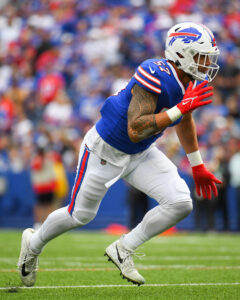 The Bills missed Jones for most of last season. Enjoying a quality start before suffering a torn pec, Jones managed to score an eight-figure guarantee at 32. Not re-signing Jordan Phillips or Linval Joseph, Buffalo will again ask Jones to anchor its interior run defense. Run stop win rate placed Jones sixth among D-tackles in 2022, and he remained effective as an Ed Oliver complement despite a 61% snap rate. With Jones out of the picture for much of last season, the Bills dropped from fifth to 15th against the run from 2022-23.
The Bills missed Jones for most of last season. Enjoying a quality start before suffering a torn pec, Jones managed to score an eight-figure guarantee at 32. Not re-signing Jordan Phillips or Linval Joseph, Buffalo will again ask Jones to anchor its interior run defense. Run stop win rate placed Jones sixth among D-tackles in 2022, and he remained effective as an Ed Oliver complement despite a 61% snap rate. With Jones out of the picture for much of last season, the Bills dropped from fifth to 15th against the run from 2022-23.
Edwards at $3MM per represents a borderline steal. Prior to a concussion-marred 2022 and working as a Bills swingman on a near-veteran-minimum contract last year, Edwards started every game for the Super Bowl-winning Rams. The former fifth-round pick also moved into Los Angeles’ starting lineup under now-Bills O-line coach Aaron Kromer. PFF ranked Edwards as a top-30 guard in 2020 and ’21; for what it’s worth, the advanced metrics site graded his 194 2023 snaps immaculately, ranking no guard higher. Even if Edwards cannot come too close to replicating that small sample size-based placement, this could still be a bargain for Buffalo.
Notable losses:
- Kyle Allen, QB
- Gabe Davis, WR
- Tyrel Dodson, LB
- Leonard Floyd, DE
- Poona Ford, DT
- Damien Harris, RB (retired)
- Deonte Harty, WR (released)
- Nyheim Hines, RB (released)
- Micah Hyde, S
- Dane Jackson, CB
- A.J. Klein, LB (retired)
- Linval Joseph, DT
- Shaq Lawson, DE
- Tyler Matakevich, LB
- Mitch Morse, C (released)
- Latavius Murray, RB
- Siran Neal, CB (released)
- Jordan Phillips, DT
- Jordan Poyer, S (released)
- Tim Settle, DT
- Trent Sherfield, WR
- Tre’Davious White, CB (post-June 1 cut)
 Just as the Packers’ David Bakhtiari injury “what if?” loomed over their early-2020s teams, White’s Thanksgiving 2021 ACL tear keeping him out of the divisional-round shootout in Kansas City may well have denied the Bills a Super Bowl berth. Like Bakhtiari, White’s injury woes lingered to the point he could no longer live up to his contract.
Just as the Packers’ David Bakhtiari injury “what if?” loomed over their early-2020s teams, White’s Thanksgiving 2021 ACL tear keeping him out of the divisional-round shootout in Kansas City may well have denied the Bills a Super Bowl berth. Like Bakhtiari, White’s injury woes lingered to the point he could no longer live up to his contract.
The Bills, who chose White after picking up an extra first-rounder from the Chiefs in the 2017 Mahomes swap, received good value early. White became a two-time All-Pro and anchored Buffalo’s CB corps, but following the ACL tear, he missed 35 games. White, 29, will count more than $10MM in dead money across the next two years.
A bigger loss comes elsewhere in the secondary. The rare seven-year starting safety duo, Hyde and Poyer — part of McDermott’s first Bills free agency class — were instrumental in the team snapping a 17-year playoff drought and becoming an AFC power. Given midlevel deals as first-time free agents in 2017, each signed a more lucrative contract. Hyde did not receive a third deal from Buffalo — though, the suddenly safety-depleted team has not ruled out one more pact — and the club dropped Poyer’s from the books, leading the latter to Miami.
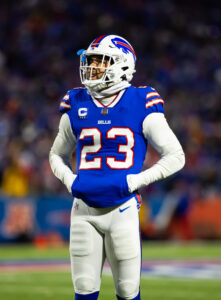 Both players are now 33; the Bills certainly received their prime years. The initial Hyde and Poyer pacts represent top-flight free agency steals, and the Bills never needed to venture into eight-figure AAV territory to extend either. Both overdelivered. While there have been better position groups in Bills history, not too many top what this safety pair accomplished during its time together.
Both players are now 33; the Bills certainly received their prime years. The initial Hyde and Poyer pacts represent top-flight free agency steals, and the Bills never needed to venture into eight-figure AAV territory to extend either. Both overdelivered. While there have been better position groups in Bills history, not too many top what this safety pair accomplished during its time together.
Floyd continued his post-Chicago surge in New York. The former Aaron Donald wingman has been one of the decade’s most consistent pass rushers. He has posted between nine and 10.5 sacks each year from 2020-23 and tallied between 18-22 QB hits each season. Adding Floyd as part-Miller insurance proved vital for the Bills, as they soon needed a true starter due to Miller’s diminished ’23 form.
The 49ers poached Floyd to complement Nick Bosa; the ninth-year vet used his one-year, $7MM Bills deal to score a two-year, $20MM contract ($12MM guaranteed). While Epenesa (soon to be 26) is six years younger, the Bills will take a risk by losing a durable, dependable edge. Of course, having Miller and Oliver’s contracts on the books present some limitations.
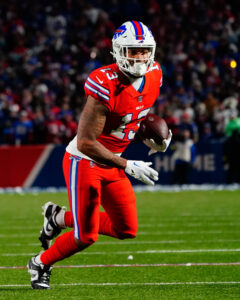 Buffalo’s 2019 Morse addition also overlapped with the team’s Beane-McDermott-era climb, as the former Kansas City second-rounder elevated his game to become a dependable Dawkins sidekick up front. Morse made a Pro Bowl and only missed six games in that five-year span. The Bills gave him two deals around the same rate (four years, $44.5MM and then a two-year, $19.5MM pact in 2022). That said, the Mizzou alum has sustained six documented concussions as a pro. The 32-year-old blocker will continue his career in Jacksonville, though his history of head injuries will unfortunately be an area to monitor regarding his future.
Buffalo’s 2019 Morse addition also overlapped with the team’s Beane-McDermott-era climb, as the former Kansas City second-rounder elevated his game to become a dependable Dawkins sidekick up front. Morse made a Pro Bowl and only missed six games in that five-year span. The Bills gave him two deals around the same rate (four years, $44.5MM and then a two-year, $19.5MM pact in 2022). That said, the Mizzou alum has sustained six documented concussions as a pro. The 32-year-old blocker will continue his career in Jacksonville, though his history of head injuries will unfortunately be an area to monitor regarding his future.
Davis and Morse can bounce Jacksonville restaurant ideas off one another — depending on the ex-Bills-turned-Floridians’ off-field rapport, of course — with the former signing with the AFC South team shortly before the center committed. The Bills will either miss Davis’ downfield chops, or the former auxiliary weapon will see his numbers impacted by Allen no longer targeting him.
Davis’ camp reminded suitors of the former fourth-rounder’s Buffalo success by pointing out the WR2 led the NFL in average depth of target, first-down rate and touchdown rate among WRs from 2020-23. Davis scored 33 TDs in that span, highlighted by his four-score performance against the Chiefs in the 2021 divisional-round epic. While the Bills might miss Davis, Allen’s skills stand to create another version at some point.
Draft:
- Round 2, No. 33 (from Panthers): Keon Coleman (WR, Florida State) (signed)
- Round 2, No. 60: Cole Bishop (S, Utah) (signed)
- Round 3, No. 95 (from Chiefs): DeWayne Carter, DT (Duke) (signed)
- Round 4, No. 128: Ray Davis (RB, Kentucky) (signed)
- Round 5, No. 141 (from Giants through Panthers): Sedrick Van Pran-Granger (C, Georgia) (signed)
- Round 5, No. 160 (from Packers): Edefuan Ulofoshio (LB, Washington) (signed)
- Round 5, No. 168 (from Saints): Javon Solomon (EDGE, Troy) (signed)
- Round 6, No. 204: Tylan Grable (T, Central Florida) (signed)
- Round 6, No. 219 (from Packers): Daequan Hardy (CB, Penn State) (signed)
- Round 7, No. 221 (from Panthers through Titans and Chiefs): Travis Clayton (T, England) (signed)
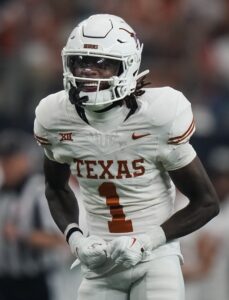 With the draft coming three weeks after the Bills traded the second-most productive wide receiver in team history, the four-time reigning division champs brought an obvious need to Detroit. How they went about filling it presents big-picture questions, as the effort involved a few other teams. One such transaction stands out.
With the draft coming three weeks after the Bills traded the second-most productive wide receiver in team history, the four-time reigning division champs brought an obvious need to Detroit. How they went about filling it presents big-picture questions, as the effort involved a few other teams. One such transaction stands out.
The Bills hosted Xavier Worthy on a “30” visit and met with Xavier Legette. On draft night, though, the made the scrutinized decision to trade down from No. 28 overall, passing on the Texas speedster. More significantly, Buffalo allowed its January nemesis to acquire him. The Chiefs are taking a gamble they can get by with a sub-170-pound speed merchant, but Worthy’s career will be tied to the Bills’ decision.
Buffalo also passed on this draft’s other high-end WR Xavier, giving the Panthers No. 32 (Legette). The Bills moved up 38 spots, collecting third-round real estate, in the Worthy trade and climbed up 59 (for early-Round 5 space) in giving the Panthers Legette. This set up the Coleman move to start Round 2.
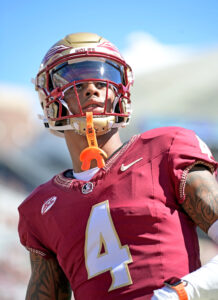 Shakir and Samuel will play big roles post-Diggs, but the Bills are counting on Coleman after he produced modest success in college. Transferring from Michigan State, Coleman did not eclipse 800 receiving yards in a season with the Spartans or Seminoles. He also lumbered to a 4.61-second 40-yard dash at the Combine. Though, the 6-foot-3 weapon’s top speed of 20.36 mph in the Combine’s gauntlet drill led all receivers over the past two years. Already submitting memorable interviews as a pro, Coleman is coming off an 11-touchdown season. Allen offered his approval after scouting wide receivers as well.
Shakir and Samuel will play big roles post-Diggs, but the Bills are counting on Coleman after he produced modest success in college. Transferring from Michigan State, Coleman did not eclipse 800 receiving yards in a season with the Spartans or Seminoles. He also lumbered to a 4.61-second 40-yard dash at the Combine. Though, the 6-foot-3 weapon’s top speed of 20.36 mph in the Combine’s gauntlet drill led all receivers over the past two years. Already submitting memorable interviews as a pro, Coleman is coming off an 11-touchdown season. Allen offered his approval after scouting wide receivers as well.
Buffalo’s decision atop its draft came down to trade offers, as the Patriots attempted to move up for Worthy as well. Given the Chiefs’ staunch postseason deterrence efforts, it is risky to provide them draft help at this juncture — especially considering the Patriots’ recent struggles. Of course, it is not known the difference in the clubs’ proposals.
The Pats ended up making their WR splash with Washington’s Ja’Lynn Polk at No. 37. He and Coleman figure to face off for years to come, while the Bills will naturally hope Worthy does not rearm the Chiefs to a frightening degree. Buffalo is believed to have shown interest in Deebo Samuel. If the 49ers extend Brandon Aiyuk soon, the Bills may be able to revisit a Samuel trade in 2025.
 Mike Edwards may be asked to start early — though, the Bills have run into injury trouble at safety — Bishop will be where the Bills want this position to settle soon. The Utah product has not gotten much practice work in due to an early-camp injury, but plans will still be in place for him to team with Rapp. Edwards and Damar Hamlin are not signed for 2025. A second-team All-Pac-12 safety in 2023, Bishop was strong against the run (21.5 career tackles for loss) and as a blitzer (7.5 sacks in three Utes seasons). He will have big shoes to fill in coverage, however, with few teams possessing the capabilities the Bills recently had at safety.
Mike Edwards may be asked to start early — though, the Bills have run into injury trouble at safety — Bishop will be where the Bills want this position to settle soon. The Utah product has not gotten much practice work in due to an early-camp injury, but plans will still be in place for him to team with Rapp. Edwards and Damar Hamlin are not signed for 2025. A second-team All-Pac-12 safety in 2023, Bishop was strong against the run (21.5 career tackles for loss) and as a blitzer (7.5 sacks in three Utes seasons). He will have big shoes to fill in coverage, however, with few teams possessing the capabilities the Bills recently had at safety.
Carter earned first-team All-ACC acclaim last season but was more productive in 2022, when he registered 5.5 sacks and tallied 11 TFLs. Carter also posted 4.5 sacks in 2021, and he was consistently disruptive at the line of scrimmage. The 302-pounder batted down 11 passes from 2021-23. Obtained via the Worthy trade, Carter will settle in behind Ed Oliver and DaQuan Jones for the time being. He could be a key supplementary rusher early.
Other:
- Promoted Bobby Babich to defensive coordinator, named interim OC Joe Brady to full-time position
- Picked up DE Greg Rousseau‘s $13.39MM fifth-year option
- Added Ronald Curry as QBs coach, Jahleel Addae as CBs coach
- Bears hired D-line coach Eric Washington as defensive coordinator
- Did not retain senior offensive assistant Mike Shula
- LB Matt Milano sustained biceps tear
- Signed 13 UDFAs, Olympic wrestling gold medalist Gable Steveson
 The Bills prioritized continuity at their coordinator positions, retaining Brady and promoting Babich. Brady’s offense leaned more on the run game, and while Allen did not curb his turnover issue following Ken Dorsey‘s firing, the Bills did fare better in the win column with the former Panthers OC calling the shots. The Bills have ranked as a top-six offense in each of the past four years, owing more to Allen’s prodigious talents than the play-caller. Considering the Bills only interviewed one other candidate — Buccaneers QBs coach Thad Lewis, satisfying the Rooney Rule — they did not appear interested in ditching another OC.
The Bills prioritized continuity at their coordinator positions, retaining Brady and promoting Babich. Brady’s offense leaned more on the run game, and while Allen did not curb his turnover issue following Ken Dorsey‘s firing, the Bills did fare better in the win column with the former Panthers OC calling the shots. The Bills have ranked as a top-six offense in each of the past four years, owing more to Allen’s prodigious talents than the play-caller. Considering the Bills only interviewed one other candidate — Buccaneers QBs coach Thad Lewis, satisfying the Rooney Rule — they did not appear interested in ditching another OC.
Forcing out Leslie Frazier and calling the shots in 2023, McDermott is considering handing the play sheet to Babich. The younger of two Babiches to work for the Bills in recent years, Bobby drew DC interview requests from the Dolphins, Giants and Packers. Babich has been on the Bills’ staff since 2017, being Hyde and Poyer’s position coach for four seasons before coaching linebackers over the past two. Father Bob Babich, a former NFL DC, had coached Buffalo’s LBs from 2017-21. The production of Buffalo’s safety tandem, along with Milano’s 2022 All-Pro season, garnered Babich interest elsewhere.
The Bills have routinely put up high defensive rankings in the regular season, being in the top four in scoring four times since 2019, before crumbling in the playoffs. Last season’s undoing — against a Chiefs offense that had been oddly shaky all season — may have been less on the coaches, as injuries sidelined roughly half the team’s starting defense. This included Milano, who missed most of last season with a severe leg injury. Despite making it back in time for training camp, the All-Pro LB faces another lengthy rehab timetable due.
 Milano’s biceps injury may not keep him out all season, but even if he returns late, the Bills are not getting much return on their recent extension (two years, $28.33MM). The 2017 fifth-rounder turned 30 this offseason, and although no guarantees are on his deal beyond 2024, a 2022 restructure will make it pricey to move on next year. It would cost the Bills $17.2MM in dead money (while generating no cap savings) to cut Milano in 2025. The team has its top linebacker signed through 2026, but the converted safety is no longer dependable. Dorian Williams, a 2023 third-rounder, will have the first shot at replacing him as a three-down player post-Dodson.
Milano’s biceps injury may not keep him out all season, but even if he returns late, the Bills are not getting much return on their recent extension (two years, $28.33MM). The 2017 fifth-rounder turned 30 this offseason, and although no guarantees are on his deal beyond 2024, a 2022 restructure will make it pricey to move on next year. It would cost the Bills $17.2MM in dead money (while generating no cap savings) to cut Milano in 2025. The team has its top linebacker signed through 2026, but the converted safety is no longer dependable. Dorian Williams, a 2023 third-rounder, will have the first shot at replacing him as a three-down player post-Dodson.
While Rousseau only totaled five sacks last season, he set career-highs in TFLs (12) and QB hits (18). The 2021 first-rounder ranked 41st in pressures as well and has batted down four passes in each of his three seasons. The Bills will continue to work with the Miami alum, who is now their top edge rusher with Floyd gone and Miller’s form uncertain. Rousseau will probably need to get home more often to prop up this year’s Bills pass rush, but Oliver’s presence will continue to help the cause.
Top 10 cap charges for 2024:
- Josh Allen, QB: $30.36MM
- Von Miller, DE: $15.15MM
- Matt Milano, LB: $12.44MM
- Dion Dawkins, LT: $11.51MM
- Ed Oliver, DT: $9.73MM
- Taron Johnson, CB: $8.45MM
- Dawson Knox, TE: $7.73MM
- DaQuan Jones, DT: $4.5MM
- Tyler Bass, K: $4.42MM
- Connor McGovern, C: $4.16MM
Allen’s presence should keep Bills championship windows open throughout his prime, but the team will test its quarterback with the rearranged receiving corps. Buffalo does return a strong offensive line and has James Cook on a rookie deal through 2025, providing some cover for the superstar QB.
The two agonizing divisional-round losses to the Chiefs have provided a roadblock, denying Super Bowl-caliber teams. Buffalo has continued to respond from postseason defeats well, earning No. 2 seeds in 2022 and ’23. More questions abound regarding the Bills’ capabilities this year, and the team will need to navigate the Dolphins once again and what should be (QB health permitting) a more imposing Jets outfit. Allen and his remaining veteran supporting cast still make the AFC East run through Buffalo, but the margin for error — both in the division and in the AFC — should probably be considered slimmer this year due to the events of this offseason.
Given all their changes and the uncertainty of injury recoveries you’d have to be Nostradamus to predict how this Bills season is going to play out.
I agree but I just get a sense the window has closed on the Bills and a regression is about to take place. It’s going to be a critical year for McDermott who might lose his job if he allows the team to sleep walk through the first 3 months of the season again. I hope I’m wrong because the fans in Buffalo are among the league’s best.
Closed? The Bills improved in several positions based on who played the last six games (plus the post-season) last year, with a more creative OC and full-time DC. Depth is less, and the safeties could be an issue, but if they remain healthy, they’ll equal, if not exceed, wins from 2023.
I doubt the Bills can afford to wait until December to start playing good football again this season. Two of those wins down the stretch were by 3 points or less so they weren’t exactly dominating anyone (as a championship caliber team should).
As long as you have a top QB, the window is never completely closed. They are simply in a re-tooling year.
If you ever played football or just a real NFL fan then you know the phrase ‘SB window closing’ is a media term as long as you have a top 7 QB and top 5 DEF your window is wide open
RetiredWarVet
Has anyone heard any “anonymity speaking” news regarding the Corey Davis workout? I feel he could be a decent signing.
Players that haven’t played in a season or more that are still at a decent age usually carry chips on their shoulders to prove themselves and reward the team that took the chance on them. I’d like to see the Bills offer him a 1-year deal.
Ben DiNucci
1st half of last season saw Allen throwing the ball all over field and running. They settled down when the interim OC started running the ball with Cook. Despite losing Diggs, they’ll still be able to move the ball but won’t be making the big plays as much. Hopefully their TE can open it up for them. Big question will be their D. They’re going to have to play well and stay in games. Their starting O didn’t look good in the preseason either. I think they’ll be a little slow out of the gates and mid season will gel and string some wins. Allen is always a threat but the AFC is stocked with tough teams.
Diggs and Davis dropped more big plays than they made ♂️
Solid 9 win team